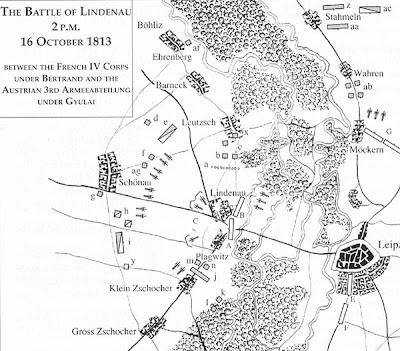Lindenau (October 16, 1813)
The battle of Lindenau (October, 16) was the western section of the battle of Leipzig, the climatic culmination of the autumn campaign in Saxony.
In 1813, Leipzig was the hub of ten major roads. Three of the roads approached the city from the west, merging into a single road at Lindenau that passed across the Elster and Pleisse Rivers on a series of bridges (5 principal and six minor ones) and causeways, forming a natural bottleneck.
Lindenau was the only real withdrawal route for Napoleon, but for some reason (maybe political Austrian considerations) the Allied did not choose to block the Napoleon's exit to France. The only Allied troops in the zone were the Ignaz Gyulai's III (Austrian) Corps, the General von Thielmann's Freecorps and the Austrian Liechtenstein's (Austrian) First Light Division, totalling (after detachments of flank-guards) around 20,000 men, a force very inadequate to take Leipzig.
The defence of the area was commended to Margaron's Leipzig garrison, that received first the help of the Quinette's brigade from the 4th Heavy Cavalry Division and around midday the help of the Bertrand's IV Corps, very diminished after its routs after the battles of Dennewitz and Wartenburg. All these tropos, including French, Italian, Badeners and Wurtembergers, amounted to around 14,000 men.
The actual battle of Lindenau was a stalemate, but the Allied achieved the immobilization of the Bertrand's Corps in this area. These troops were desperately needed in the southern front (Wachau), where just one more Corps would probably have given the victory to Napoleon.
Bibliography
- Hofschröer P., Leipzig 1813. The Battle of Nations Osprey Publishing, London, 1993
- Nafziger G., Napoleon at Leipzig. The Battle of the Nations 1813. The Emperor Press, Chicago, 1996
- Riley J.P., Napoleon and the World War of 1813, Frank Cass, London, Portland, 2000
- Smith D., 1813 Leipzig. Napoleon and the Battle of the Nations Greenhill Books, London, 2001


































No comments:
Post a Comment